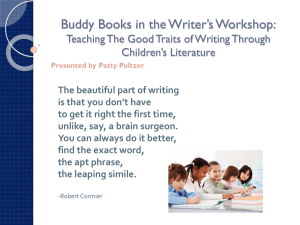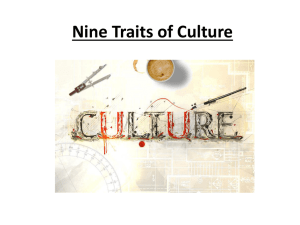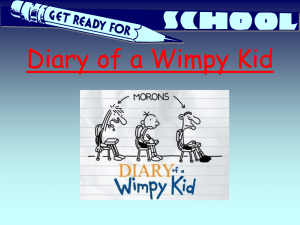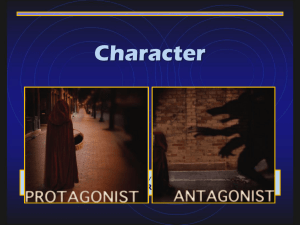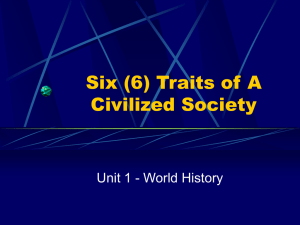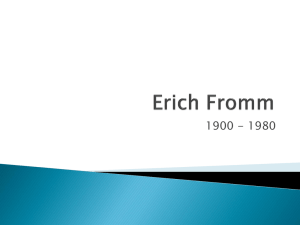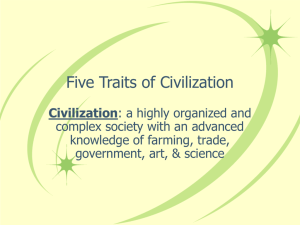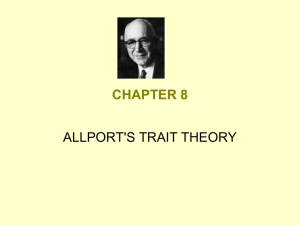6 Traits Workshop-Katy Barolini PP - CHILD-Fans
advertisement
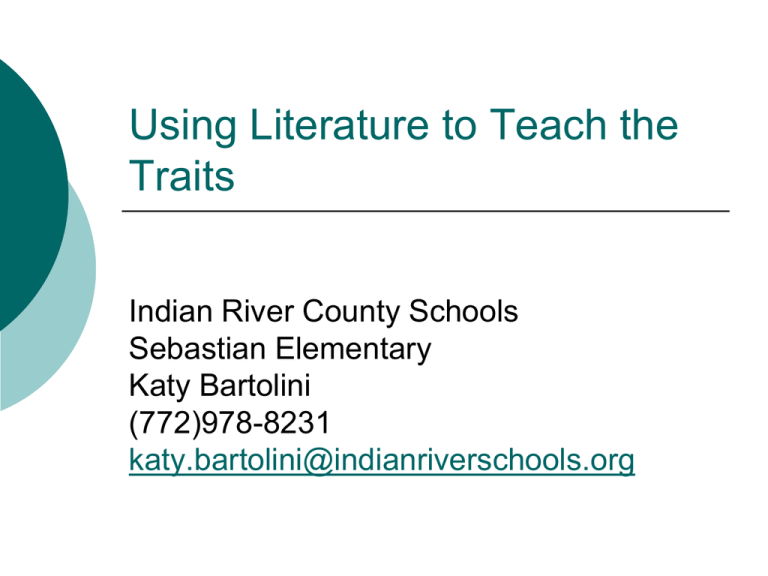
Using Literature to Teach the Traits Indian River County Schools Sebastian Elementary Katy Bartolini (772)978-8231 katy.bartolini@indianriverschools.org Introduction Using the 6 Traits of Writing and incorporating literature to model the traits. These skills and strategies are used daily to reinforce writing skills. Using technology to enhance the writing curriculum. Agenda Teaching the traits of writing literature ● Ideas ● Organization ● Voice ● Word Choice ● Sentence Fluency ● Conventions Writer’s Workshop includes 4 main components Modeled Writing Independent Writing Conferencing Sharing Teaching technology through writing projects. Publishing Station Writing Station Overview Writers will become Readers and Readers will become Writers Read Draw Model Think Pair Share Edit Write Words Vocabulary Ideas – attention to detail, tells the whole story. Organization – pictures and text go together, the piece has a beginning, middle, and end Voice – writer’s passion for the topic Word Choice – builds a picture for the reader Sentence Fluency – sentences vary in structure and length. Conventions – Capitalization, punctuation, grammar Writing Activity Book - Where the Wild Things Are by: Maurice Sendak discuss traits that compliment the book use materials on the table to create your own “Wild Thing”. write a story describing your adventures if you were a “Wild Thing.” Literature to Teach the Traits Ideas • If Dogs were Dinosaurs by David M. Schwartz • Out of the Ocean by Debra Frasier • Owen by Kevin Henkes Organization • I Wanna Iguana by Karen Kaufman Orloff • Scaredy Squirrel by Melanie Watt • How the Grinch Stole Christmas! By Dr. Seuss Literature to Teach the Traits Voice • The Relatives Came by Cynthia Rylant • The Grouchy Ladybug by Eric Carle • When Sophie Gets Angry-Really, Really Angry by Molly Bang Word Choice • Fancy Nancy by Jane O’Connor • Piggie Pie by Margie Palatini • The Jacket I Wear in the Snow by Nancy Winslow Parker Literature to Teach the Traits Sentence Fluency • • • The Important Book by Margaret Wise Brown Millions of Cats by Wanda Gag Hey, Al by Yorinks Conventions • • • Duck on a Bike by David Shannon Grouchy Ladybug by Eric Carle Alexander & the Terrible Horrible, No Good, Very Bad Day by Judith Viorst Make and Take Activity 1 April Shower’s Mobile – Publishing Station ● ● ● ● ● ● ● Trace and cut out a white cloud. Trace and cut out nine blue raindrops. Trace and cut out three red flowers. Trace and cut out three green stems. Glue three white strips to the cloud. Glue the raindrops to the strips. Glue a flower and stem to the bottom of each strip. April Poem – Computer Station ● ● Type the poem you found about the month of April. Glue it onto your April Mobile. Make and Take Activity 2 Butterfly Mobile – Publishing Station • • • • Use the templates to cut out the butterfly shapes from blue, yellow, and pink paper. Also cut 2 each of the large and small circles from each color. Lay out the 3 butterflies and position the spots so there are contrasting colors on each one as shown. Punch 2 holes in each butterfly as marked on the templates. Thread the yarn through the butterflies. Butterfly Poem – Computer Station • • Write your Haiku Poem Attach your poem to one of your butterflies on your mobile. Make and Take Activity 3 Ladybug Activity – Publishing Station • • • • Trace and cut out 3 body parts, 6 legs and 2 antenaes. Glue the body parts together and attach the writing paper. Go to Mrs. Bartolini and she will attach the wings. Write about a time Make and Take Activity 4 Short Vowel Sounds Sort – Textbook Station • • • • • • Take out a piece of paper. Fold it like a hot dog. Label each side with e and o. Cut out the pictures. Say the picture out loud and see if you can hear the short e or short o sound. Glue the picture on the correct side of your paper. Color the pictures. Summary Model the skills you wish to teach the children once a week during Writing Workshop. The other days of the week, teach a mini-lesson using the traits before individual writing time. The children NEED to write daily in a journal. They need to have a conference with the teacher 2-3 times a week. Provide the tools necessary to help their writing grow. Build the children’s writing skills at their own pace. Writing is successful when you start the children at their own individual level and build on their skills from there. Where to Get More Information Resource Books Wee can Write by Northwest Regional Educational Laboratory Using Picture Books to Teach Writing With the Traits by Ruth Culham & Raymond Coutu Seeing with New Eyes by Northwest Regional Educational laboratory picture books by Northwest Regional Educational Laboratory Just Write: All Year Long Kindergarten by Kathryn Robinson Never Too Early To Write by Bea Johnson Teaching the Youngest Writers by Marcia S. Freeman


